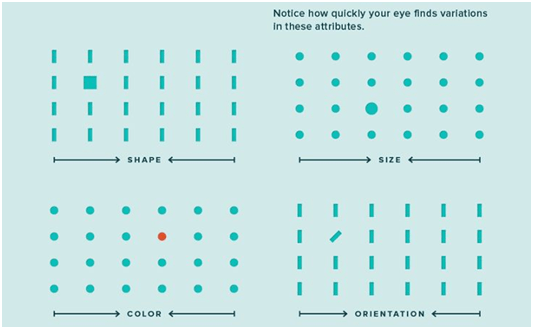One of my favorite presentations of all time is Julian Treasure’s TED Talk called “5 Ways to Listen Better.” As a professor of communication, I love, love, love the subject of the talk. But I also love the way he turns his presentation into a multimedia experience through the use of visuals. One of my favorite moments comes when he shares a particularly moving visual that syncs beautifully with his words.
He is talking about the shared soundscapes that we experience in public. As he does, the screen behind him is solid blue. But then he says that many of us have started to take refuge from noise by using headphones. He says that these headphones are turning shared soundscapes “into millions of tiny, little personal sound bubbles.” And as he says those words, the solid blue screen separates into hundreds of small blue circles. Then he says, “in this scenario, nobody is listening to anybody.” The visuals drive the point home in an undeniably powerful way. (Jump to about 2:30 to see this part of his talk.)
As presenters, we should be showing and telling, not telling and telling. We can make our messages so much more entertaining, lasting, and effective when we use strong presentation visuals. Here are 3 specific and scientifically-proven reasons to make visuals a priority for your next presentation.
We Understand Visuals Faster
For those of us who are visual learners, and that’s a vast majority of us, it benefits us to see a concept or process presented rather than to hear it. Visuals can quickly usher in an “a-ha!” moment. You’ve probably experienced this before. Once you see something, somehow it just clicks. That’s because we tend to understand images faster than words.
Consider these statistics from the Visual Teaching Alliance:
- 90% of the information transmitted to the brain is visual
- We process visuals 60,000 times faster than text
- We can see images that only last for 13 milliseconds
So you can actually save time in your presentation by presenting concepts visually. If you feel crunched to include everything during your given time allotment, try moving some concepts from a verbal presentation (explaining them with words) to a visual presentation (showing them with pictures).
We Retain Visuals Longer
Another reason to use visuals is that they stick with us longer. Dr. Lynnell Burmark says, “Words are processed by our short-term memory where we can only retain about 7 bits of information (plus or minus 2)… images, on the other hand, go directly into long-term memory where they are indelibly etched.”
Whenever I see someone wearing headphones of any kind, I’m immediately reminded of the example from Treasure’s talk that I mentioned above. That image, as simple as it was, will probably stick with me until the day I die. That’s because it so clearly and simply illustrated a modern problem.
We Process Visuals More Easily
Here’s the final reason we need to use visuals in our presentations. We easily process visual information. Educator Dana Jandhyala says that “we are pre-wired to automatically interpret relationships between objects which ensures instant comprehension with almost zero effort.” Check out this graphic she shares which shows how quickly our brains recognize variations and relationships.

Our pre-wiring for visuals is often referred to as “preattentive processing.” The Interaction Design Foundation says that because this type of visual processing takes place in sensory memory, “it requires no conscious effort from the user” which allows us to “grab the attention of the user without their input or effort.” In other words, when we use visuals in our presentations, the audience doesn’t have to work as hard.
Keep the importance of visual information at the forefront of your mind. And make sure your presentations from here on out are more show and tell, than tell and tell.
And if you need help, Ethos3 is here for you—from presentation design to delivery. Get in touch with us now for a free quote.